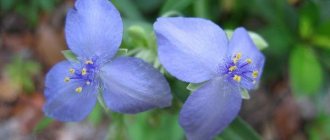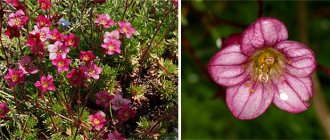Crocus (Crocus), or saffron, is a genus of bulbous herbaceous plants that belongs to the Iris family. In the wild, this plant is found in Southern, Central and Northern Europe, the Middle East, the Mediterranean, Central and Asia Minor. Crocuses prefer to grow in forests, steppes and meadows. There is a description of 80 species of this plant, as well as 300 varieties. The name "crocus" comes from a Greek word that translates as "fiber, thread." The name “saffron” comes from the Arabic word meaning “yellow”, this is because the stigmas of the flowers are exactly that color. Mention of this plant was found in Egyptian papyri; both doctors and philosophers wrote about crocus. These days, this plant is also very popular among gardeners, because it is one of the most beautiful primroses (early spring flowers). But few people know that there are a large number of species of such plants that bloom in autumn.
2.Description - what a crocus looks like
What kind of crocus plant is this? Crocus or saffron are miniature, perennial, bulbous plants.
The bulbs are slightly flattened, brown or white, 1 - 2 cm in diameter, at the base they bear well-developed, long, light roots. Each bulb during the flowering period is capable of producing 1 - 2 buds.
The leaves are long and very thin, delicate, green, often with a lighter, almost white longitudinal stripe in the center, up to 10 cm long, appearing directly from the tops of the bulbs.
The flowers often appear before the leaves and are very attractive, pink, lilac, lavender, blue, yellow or white. The petals of some varieties have stripes or spots, and are also colored in 2 different shades.
Each flower, up to 5 cm in diameter, bears large yellow stamens with lots of orange pollen.
Many species have a pleasant and rather strong aroma that attracts pollinating insects.
Height . Up to 20 cm.
Bloom
You can often come across a question from inexperienced gardeners who came up with the idea of growing crocuses when these plants bloom.
The flowering period can vary depending on the variety. Goblet-shaped flowers located on short stems have 6 petals. After blooming, the flowers take on a star-shaped or cup-shaped shape. The inflorescences are painted in various shades. Pollination of flowers is carried out by insects.
Reference! The combination of yellow and red crocus looks very impressive in a flowerbed. Flowers grow quite quickly, but not every variety can please you with flowering in the year of planting.
3.Crocuses - planting and care
The timing of planting in open ground will depend on the time of flowering. If a variety of crocus forms buds in the spring, then such a flower is planted in the fall - around the end of October or in the first half of November . If flowering occurs in the autumn, then spring months .
To plant crocus bulbs, prepare a plot of soil with good lighting or located in the open shade of shrubs and trees.
Constantly flooded areas are not suitable for growing crocuses - the bulbs will rot in such conditions.
The soil is dug up and weeds are removed. To improve nutrition, a sufficient amount of organic matter is mixed into the soil - humus or well-rotted manure. If there is no organic matter, then the substrate can be enriched with superphosphate granules.
↑ Up,
In order for the soil to better allow moisture to pass through and become loose, river sand and wood ash are added to it.
If the soil has an acidic pH, then it must be adjusted by adding lime or crushed chalk.
Holes are prepared for planting , the distance between which is maintained in accordance with the planting scheme. Crocus can be planted in groups and used as a border plant.
The depth of the planting holes should be 2-3 times the height of the bulbs , and a layer of river sand should be poured onto their bottom, which will facilitate better drainage of moisture after watering.
If the soil on the site is heavy and clayey, then the bulbs can be planted to a depth 2 times greater than the height of the bulbs, and if the soil is loose, then the bulbs can be buried.
Since the crocus quickly forms daughter bulbs and they become crowded, a distance of 7 - 12 cm .
↑ Up,
Before planting, the bulbs are soaked for half an hour in a fungicide solution or a weak solution of potassium permanganate.
Only healthy planting material is chosen for cultivation - the bulbs must be dense, without soft areas and mechanical damage.
There should be no wrinkles, spots or any manifestations of disease on the surface of the scales. The scales should fit snugly against the walls of the bulbs and not puff up.
The bulbs are placed in planting holes and watered with sufficiently warm water. The surface of the ground after planting can be lightly compacted.
The seeds of the plant are also suitable for planting in open ground . Planting dates may vary regardless of the timing of flowering.
For autumn planting, a time is selected so that the first shoots do not have time to appear before the onset of winter. During autumn planting, the seeds will go through a period of cool stratification naturally.
Before sowing crocus seeds in the spring, they are sprinkled with a small amount of damp river sand and placed in the refrigerator for 3 weeks to undergo cool stratification.
↑ Up,
3.1.Care in open ground
Caring for a crocus is not difficult - the flower is quite unpretentious and does not require careful care.
When grown in open ground, the flower is periodically fed and the soil surface is loosened. The area is also periodically weeded to remove harmful weeds.
Water the plants only when the soil dries to a depth of several centimeters.
For spring-flowering plants, the first fertilizing is applied on the snow , evenly distributing fertilizers over its surface. As the snow melts, it will saturate the soil with nutrients. For fall-flowering varieties, fertilizing begins when the first signs of new growth appear.
The second feeding of flowers is carried out when the buds form and the last one is done after flowering.
↑ Up,
In the autumn months, for bulbs overwintering outside, it is worth organizing a shelter - sprinkling the area with a thick layer of mulch made from straw or rotted sawdust. Without additional shelter, the bulbs can tolerate frosts down to -18 degrees Celsius.
If rodents appear on the site, then after the above-ground part of the bulb dies, it is better to dig it out of the soil and bring it indoors for storage. Only plants with completely dead leaves are dug up - for spring-flowering varieties, this period begins in mid-summer. Autumn-flowering varieties are dug up in June.
During one season, each bulb can form 2 - 10 daughter bulbs, and over time, a whole carpet of flowers can form in the place where one plant is planted. Such thickened plantings are replanted every 3 - 5 years .
↑ Up,
If the plants are not planted, the crowding will contribute to the formation of smaller flowers, and over time, the buds will stop forming altogether.
For replanting plants that bloom in spring, the autumn months are used, and for varieties that bloom in autumn, it is accordingly better to use spring replanting.
After digging, the bulbs are cleaned of old soil and dried in a warm place.
Store planting material in a dry, dark and fairly cool place until planting at a temperature of about 4 - 9 degrees Celsius.
↑ Up,
Features of forcing
Blooming crocuses are a real decoration. It is not difficult to drive out these plants . We offer some simple tips.
Selection of planting material
Dutch hybrids are the most suitable for this. With their help you can get large and impressively beautiful plants. When choosing a variety, it is better to focus on flowering periods. The bulbs must be completely healthy and have a diameter of at least 5 cm.
Cooling
Rooting of bulbs in nature occurs successfully at low temperatures. You can place containers in garden soil. But there is another option: use a refrigerator or cellar , where the temperature is kept between +4–9 degrees.
Each pot is sealed with film. When dry, the soil is moistened.
Rooting flowering
For positive results, you should cool the bulbs before planting and choose the right containers and soil. Keep the plantings in the dark for a couple of months (until green sprouts appear).
This video talks about the features of forcing Crocuses.
This video shows the forcing of Crocuses after three months.
4. Propagation of crocuses
Crocus propagates by small daughter bulbs or seeds. The bulbs are separated from the mother bulbs during transplantation. The first buds will decorate the plants obtained by division after 2 - 3 years .
You can also grow crocus from seeds. Seed propagation is quite easy and when growing a flower under it you can often find self-seeding.
Not all varieties form seeds, even when pollinated. When grown in the central zone, autumn-flowering varieties do not have time to form seeds, so this method of propagation is suitable only for spring varieties.
After flowering, the plants produce seed pods that become dry and brown when ripe. Each seed pod contains large, reddish-brown seeds.
After collection, the seeds are dried and stored until spring in a dry and cool place, packed in fabric bags or paper parcels.
↑ Up,
- Before planting, the seeds are soaked in a solution of epin or zircon for half an hour and dried.
- In the spring, small cups or pots with drainage holes are prepared for sowing seeds.
- Expanded clay is placed at the bottom of the cups - it will allow moisture to drain faster from the pot after watering.
- Fill the pots with a nutritious and loose soil mixture, which is thoroughly moistened.
- Seeds 2 - 3 pieces. sow on the surface of the soil and cover the top with soil about 7 - 10 mm thick.
- After sowing, the soil surface is also moistened with a spray bottle.
- For 3 weeks, the cups with seeds are sent to the vegetable compartment of the refrigerator so that they undergo cool stratification.
- After stratification, the cups are placed in a room at room temperature.
- Cups with seedlings are placed in a well-lit place with plenty of reflected sunlight, out of direct rays.
- To create a greenhouse effect, the seedlings are covered with a plastic cap or transparent plastic film. Every day the cover is removed and the crops are ventilated, each time increasing the ventilation time.
- 2 - 4 weeks after sowing, shoots may appear for the first time.
↑ Up,
As the plants develop, they grow into larger pots. Feed the flowers every time after picking - after 10 - 15 days.
Plants obtained from seeds bloom only after 4 - 5 years .
Since seed propagation requires a long period of time before flowering, it is carried out mainly by breeders to develop new varieties of flowers.
↑ Up,
Bulb storage
After being removed from the ground, crocus bulbs are dried in the shade, cleaned of soil, dead roots and scales, and laid out in a single layer in a box or box. The smallest bulbs can be placed in candy boxes. Until August, the storage temperature should not be lower than 22 ºC, because a lower temperature will prevent the formation of flower buds. In August, the temperature is lowered to 20 ºC, and a week later to 15 ºC. But these are ideal storage conditions, which are created only in specialized farms. At home, before planting, crocus bulbs are stored in a dark, dry place with room temperature and good ventilation.
In the photo: Growing crocuses in the garden
5.Growing at home
5.1.Containment temperature
When growing in pots, create the conditions in which crocuses are found in nature.
, bulbs of spring-flowering varieties must undergo preliminary cold stratification for 12 - 15 weeks at a temperature of about 5 ° C.
° C for some time until the first signs of growth appear.
When the leaves reach a height of 3 - 5 cm, the plants are transferred to a warmer place - with a temperature of 10 - 15 ° C.
After flowering, the temperature can be increased slightly - to about 17 ° C. If the air temperature rises above 20 ° C, the flowering time will be greatly reduced.
↑ Up,
Low night temperatures , bordering on negative, contribute to prolongation of flowering time In such conditions, buds will decorate the plants for 3 weeks.
Do not be afraid of low temperatures - in their natural environment they tolerate frosts down to 10 - 15 ° C even when they are blooming.
↑ Up,
↑ Up,
5.2.When the home crocus blooms
Under natural conditions they bloom in very early spring ; flower stalks often break through the snow. Among the crocuses there are not only primroses, but also varieties that bloom in the autumn months .
When forced, it can bloom at any time of the year. The flowering period can last 2 - 3 weeks if the plants are kept cool and away from direct sunlight.
When growing for forcing, you should be guided by the fact that the first buds appear approximately 3 months after planting the bulbs .
↑ Up,
Unfortunately, the specific timing of flowering may depend not only on maintenance conditions, but also on varietal characteristics, so in order to get a flower by March 8 , it is worth adapting to a specific variety over the course of a couple of years.
For flowering in the second half of winter or early spring, it is better to use spring-flowering varieties, and for forcing in autumn, of course, it is better to use autumn-flowering varieties.
For forcing, large-flowered plants of Dutch selection are most often used - they will fully comply with the declared characteristics even when grown at home.
↑ Up,
5.3.Lighting
During the dormant period, when the crocus plant loses its leaves, the bulbs are stored in a dark place.
During the forcing period, place the pots in a well-lit place where they can receive 4 - 6 hours of direct sun every day.
When the buds open, you can move the crocuses to the shade, as in such conditions the flowers will remain open longer. Exposing flowers to direct sunlight can shorten flowering time .
If there is a lack of sunlight, artificial lighting can be used. Using LED or fluorescent lamps, crocuses are illuminated in the morning or evening hours to increase the length of daylight.
↑ Up,
5.4. Growing crocus at home - forcing
How to care for crocus at home? In homes, crocuses are often used for forcing - using different planting dates, you can get a living bouquet from the bulbs by any desired date. Only mature, strong bulbs are suitable for forcing.
The planting material must be the same size - for bulbs of different sizes, flowering dates may shift, and the buds can also be of different sizes.
Such plantings bloom in the house for 1 season ; in the second year, it is better to move the plants to open ground.
Some varieties, such as golden-flowered crocus, are not suitable for forcing - even with careful adherence to agricultural practices, the buds do not open and remain dry in the foliage.
↑ Up,
After flowering, the leaves will begin to yellow and die - do not remove them as they will continue to feed the bulbs. Only flower stalks with fading buds should be pruned. Such flower stalks are separated from plants using a sharpened sterile instrument.
Plants that bloomed at home should be planted outside . The bulbs are removed from the substrate when the above-ground part dies off and a dormant period begins.
↑ Up,
Before storing the planting material, it is cleared of the remnants of old soil. After flowering, the bulbs are stored in a dark and cool place with a temperature of about 5 - 9 ° C, in a peat mixture, which is occasionally moistened, or in paper bags.
Every week the bulbs are taken out and sorted , checking for rot.
Autumn-flowering plants require a higher temperature for storage - about 20 ° C - it is under these conditions that flower buds are formed.
↑ Up,
5.5.Soil
Crocus needs soil rich in organic matter and well-drained, for example a mixture of leaf humus and a small amount of peat.
The flower does not like substrates whose pH levels are low - in other words, acidic soils. Neutral or slightly alkaline soils will be preferable for keeping plants .
To improve moisture permeability, it is worth adding coarse river sand or perlite and vermiculite to the soil.
The finished mixture should be nutritious and easily allow air to pass through, allowing the root system to breathe.
↑ Up,
5.6.Transplanting crocuses
Crocuses are planted annually, in autumn or spring, in shallow bowls with large drainage holes.
- A drainage layer of expanded clay, clay shards, broken bricks or pieces of polystyrene is placed at the bottom of the pot.
- Fill the pot with nutritious and loose soil mixture, so that the surface of the substrate is 5-6 cm below the walls of the pot.
- In order to get a fairly lush bush, 5 - 10 bulbs are planted in each pot.
- Place the bulbs on the ground so that there is about 2 - 3 cm of soil between them. The bulbs should not touch the walls of the pot when planting.
- From above, the planting is covered with a layer of substrate 2-3 cm high. In the upper part, instead of soil, you can use river sand - it will quickly remove moisture from the bulbs after watering and will prevent the development of rot.
- The planted flowers are watered with water at room temperature. The next watering should be carried out only when the first leaves appear above the soil surface.
It is better to plant faded bulbs in the garden; they are unlikely to bloom twice at home.
↑ Up,
5.7.Feeding crocuses
Annual planting in fresh soil allows crocuses to do without additional feeding in most cases.
If the soil is not nutritious enough, pamper the flower with liquid mineral fertilizers for flowering plants 1 - 2 times a month before flowering . After flowering, it is worth carrying out 1 - 2 more feedings , preparing the bulbs for the dormant period.
The nutrient solution is diluted to half the dose recommended on the package and added to moist soil , previously watered abundantly. Contact of a concentrated solution on the root system in dry soil can cause a chemical burn to the roots.
↑ Up,
You should not feed only planted plants and flowers that have any signs of disease.
When growing crocuses, you should not use mineral fertilizers with a high nitrogen content - with such fertilizing, the bulbs become overgrown and loose, and are easily susceptible to rot and fungal diseases.
Crocus can be fed with both mineral solutions and organic matter. As organic , you can use cow or horse manure, a solution of bird droppings, and humus. All organic matter used must be well rotted.
Plants are more likely to tolerate a lack of nutrients by using up the reserves that are in the bulbs than an excess amount of fertilizer.
↑ Up,
5.8.Air humidity
Does not require spraying and can tolerate fairly dry air. Atmospheric humidity is increased mainly to protect the flower from the invasion of harmful insects.
To increase humidity, you should not use spraying - droplets of moisture falling on flowers and buds can ruin their appearance.
↑ Up,
It is better to place the flower pot on a tray filled with wet gravel and periodically spray the pebbles. With this growing method, the surface of the water should always be below the bottom of the pot.
room humidifier helps increase humidity , but you can do without it - just place any wide, open container of water .
Keep plants in ventilated areas with good flow of fresh air.
↑ Up,
5.9.Water crocuses
The frequency of watering when growing crocuses will depend on the ambient temperature and the stage of flower development.
After planting, the first waterings should be limited and quite rare - at this time the crocus does not yet have leaf plates that evaporate moisture into the atmosphere. Excessive watering at this time will lead to rotting of the bulbs.
As the green mass develops, the frequency of watering is gradually increased.
↑ Up,
Regularly moisten the soil in pots when the crocus forms buds.
After flowering, when the leaf blades begin to turn yellow, gradually reduce the frequency of watering so that after the leaves die off, the bulbs are in almost dry soil.
Water the plants with settled tap water at room temperature.
It is best to water the plants in a tray - in such conditions the bulbs will grow roots to meet the incoming moisture.
↑ Up,
Place
The place for planting crocuses should be open, sunny (but light partial shade is also possible, where flowering lasts longer), direct rays should illuminate the flowers for at least 4 hours. In spring it should not be flooded, otherwise the corms will rot.
- Sandy and loamy soils are suitable.
- Loose and nutritious soil should be added to clay areas.
- Acidic soils are not suitable - flowers will practically not grow on them.
Before planting, you can add mineral fertilizers for bulbs, compost or humus, and loosen the soil with sand. On acidic loams, ash must be added.
An important rule of crop rotation: do not plant crocuses after bulbous ones.
7.Purpose
Can be used for forcing, but it will require some effort to maintain temperature and lighting conditions.
Different varieties of crocuses bloom at different times, and by placing several different bulbs in one pot you can enjoy flowering for longer.
Crocus stigma or saffron is a valuable seasoning that is sometimes used in cooking. Saffron was also used to dye fabrics and foods.
↑ Up,
Using coloring, the seasoning can be checked for naturalness. When a few stigmas are added to a few liters of water, it turns a uniform yellow or orange color. Artificially created seasoning does not have this effect.
Interestingly, crocus bulbs are also considered edible - they are eaten after cooking.
Flowers look very advantageous in group plantings and when grown on alpine hills .
Crocuses are one of the very first plants to decorate the garden plot with their blooms in the spring.
↑ Up,
↑ Up,
What kind of soil does a flower like?
Saffron is a completely unpretentious plant that feels good in any type of soil. Permeable light loams are an excellent choice for it, and some varieties grow and develop well even on heavy clay soil.
As for the soil itself, it should be: loose, nutritious, light and dry.
Attention : gardeners often build saffron beds on a hill. Since excess moisture threatens them with the formation of rot.
8.Note, interesting facts
Crocus stigmas are used to make seasonings (another name is saffron) and for medicinal purposes.
In Europe, crocus became a symbol of wealth and superiority, as it was worth fabulous money as a seasoning. The flower is often used as a heraldic symbol - it is depicted on the coats of arms of the city of Mozdok (North Ossetia), the municipality of Letux (Spain) and others, and was also often depicted on various coats of arms in France.
Considering that the crocus often breaks through the thickness of the snow and appears immediately with buds, the flower can be considered a symbol of perseverance and strength, as well as a symbol of the awakening of nature.
In China, only emperors could wear saffron-colored clothes. The flower acquired a negative connotation in Ancient Rome - it became a symbol of wastefulness, since purchasing saffron for huge sums of money, the floor of the room was covered with the precious seasoning during feasts.
Crocus sativus is used in homeopathy.
Hydroponics.
9.Varieties:
9.1.Valley saffron - Crocus vallicola
Flowering bulbous perennials with thin and long petals, often colored white. The tips of the petals are sharp. Often the petals have thin lilac stripes. This variety belongs to the autumn-blooming mountain crocuses and is often found in the Caucasus. Flowers appear even before leaves form.
↑ Up,
9.2. Spring crocus - Crocus vernus
A widespread variety among flower growers. They are miniature plants with large bulbs. The leaves are uniform, dark green, hard, straight with a pronounced central vein. The peduncles are short, bearing single delicate flowers at the tops. Petals can be painted in white, lilac, purple, yellow shades. Often on the surface of the petals there are thin longitudinal stripes of a darker color. The flowering period begins in spring and lasts about 3 weeks. Interestingly, at night and in cloudy weather, the flower petals remain closed.
This species was used by Dutch breeders to develop modern large-flowered crocus varieties.
↑ Up,
9.2.1. Crocus vernus Remembrance
One of the varieties bred on the basis of spring crocus. These are large-flowered crocuses that can be used for forcing at home. Foxes are green, narrow, with a narrow and light stripe running along the central vein. Peduncles are short and powerful. The flowers are goblet-shaped with plain, brightly colored petals of lilac or purple.
↑ Up,
9.3. Crocus (saffron) sativus or sativus - Crocus sativus
An autumn-blooming crocus with long, red threads inside the flower - anthers. It is from this flower that the well-known seasoning, saffron, is made. The leaves are dark green, long, arched, monochromatic. Peduncles are short, vertical. At the tops of the peduncles there are single, large flowers with wide-open lilac petals. The center of the flowers is often darker in color.
↑ Up,
9.4.Crocus Kochi - Crocus kotschyanus
Quite large autumn-flowering plants, the bulbs of which can reach 9 - 10 cm in diameter. Flowering often occurs after the leaves die. The leaves are dark green, narrow, linear, with a central silver vein. The flowers are delicate, single, with thin, oblong petals in pastel shades of lilac, pink or white. There are almost always thin dark stripes on the surface of the petals. The center of the flowers has a yellow-orange circle.
↑ Up,
9.5.Crocus speciosum
Bulbous perennials with autumn flowering, 10 - 15 cm in height. The flowers have oblong, sometimes pointed petals of delicate shades and resemble colchicum. The center of the flower is often lighter. Flowering occurs after the leaves die. The leaves are green, linear.
↑ Up,
9.5.1. Crocus Cassiopeia - Crocus speciosus Cassiope
One of the late-blooming varieties, with bluish or lilac flowers in delicate shades. A distinctive feature of the plant remains the bright, branched stamens in the upper part.
↑ Up,
9.5.2.Crocus speciosus conqueror
Plants with autumn flowering. The flowers are bluish or lilac, located on thin, erect peduncles. The bright, orange stamens contrast perfectly with the pointed petals of this variety. The center of the flowers is yellow.
↑ Up,
9.6.Korolkova saffron - Crocus korolkowii
Perennial primroses with narrow, dark green, hard, straight leaves. There is a light stripe in the center of the leaf blades. Peduncles are quite short, often do not exceed the height of the leaves, and bear small, very similar buds at the tops. The flower petals are painted in a bright, golden-orange hue, and their outer side remains brown or burgundy.
↑ Up,
9.7.Crocus chrysanthus
Perhaps one of the most diverse group of buds in the color of the plant. Flowers can be colored in shades of yellow, white, lilac, purple. The outer side of the petals often remains dark - purple, brown or burgundy. Some varieties may have buds colored simultaneously in several shades, smoothly transitioning from one to another.
↑ Up,
9.7.1. Crocus chrysanthus Fuscotinctus
A spring-flowering variety of crocus with very thin, needle-like, dark green leaves. A distinctive feature of the plant is its goblet-shaped flowers with golden petals. The outer side of the petals has longitudinal brown or burgundy stripes.
↑ Up,
9.7.2.Crocus Goldilocks
The variety is characterized by half-opened bright golden flowers with uniform, oval petals. Flowering occurs in spring.
↑ Up,
9.7.3.Crocus chrysanthus Aubade
Very tender plants with spring flowering, have glossy, slightly curved, green leaves. Flowers with white, fairly wide petals and a yellow center. The stamens, like most crocuses, are bright orange.
↑ Up,
9.8.Crocus sieberi
Even for crocuses, this variety remains one of the smallest - plants can reach only 7 - 10 cm in height. Bulbous perennials with early spring flowering. The leaves are narrow, linear, green. The flowering is so profuse that the leaves often remain completely hidden by the flowers. The peduncles are quite short and often remain below the leaves. The flowers are wide open, with 6 oblong petals, painted in white, pinkish, lilac or purple shades.
↑ Up,
9.8.1.Crocus Tricolor - Crocus sieberi Tricolor
One of the brightest varieties of Crocus Sieber has flowers with wide, almost rounded petals, painted in 3 different shades - purple, white and orange in the center of the flower.
↑ Up,
9.8.2.Crocus sieberi Firefly
Delicate flowering herbaceous plants with bluish-green, thin leaves and powerful, short, vertical peduncles. These plants apparently got their name “firefly” for the bright color of their buds - lilac or pinkish flowers with an orange center contrast very nicely with the dark leaf blades.
↑ Up,
9.9. Banat crocus - Crocus banaticus
An autumn-flowering variety, often the plant height does not exceed 5 cm. The leaves are linear, green, monochromatic. Flowering occurs after the leaves die; the flowers have delicate, purple, lilac, pink or white petals. During flowering, the plants emit a pleasant sweetish aroma. The structure of the flowers is interesting - 3 petals grow to large sizes, another 3 remain small and are located inside the flower. The buds are lilac, branched at the top of the stamen. Sometimes the flowers of the Banat crocus resemble the buds of its closest relative, the iris.
↑ Up,
9.10. Multi-colored crocus - Crocus versicolor
Spring flowering plants have dark green leaves with a light stripe in the center. Peduncles are white, short. The flowers are often half-open and have white or lilac, pointed petals and a yellow center with orange stamens.
↑ Up,
9.10.1. Crocus picturatus - Crocus Versicolor Picturatus
A white-flowered variety, the flower petals have dark, purple stripes on the outside.
↑ Up,
9.11. Sharoyan's Crocus - Crocus scharojanii
Autumn flowering variety. The plants have elegant and austere, goblet-shaped, golden-orange flowers that remain half-open. Interestingly, among autumn crocuses this species is the only one with golden flowers. Flowering occurs after the leaves die.
↑ Up,
9.12. Crocus Tommasini - Crocus tommasinianus
The variety has flowers with pale lavender or purple petals. Peduncles are thin, vertical. The flowers close at night and open in the morning, but usually remain closed in rainy and cloudy weather. The plants are classified as primroses. Each bush has 3 - 5 narrow, linear leaves during flowering.
↑ Up,











